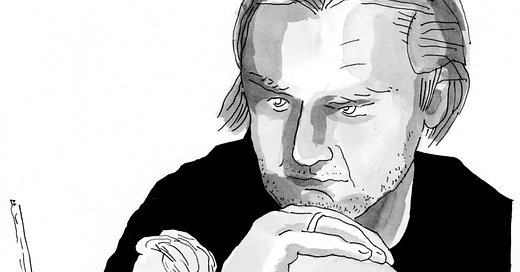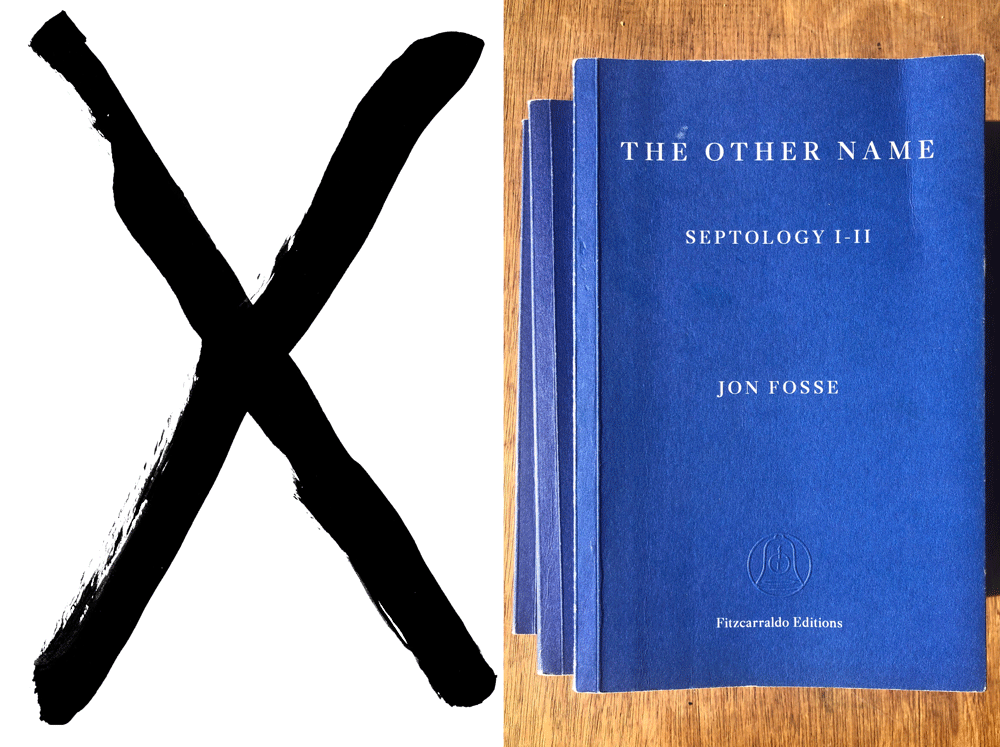Doubt.
On the first page of the first volume of Jon Fosse’s A Septology, Asle, a successful painter and ex-alcoholic, crosses a purple brushstroke over a brown brushstroke and accidentally creates a St Andrews Cross. He worries about it from volume one through volume seven, over eight hundred pages. He meets another Asle, his double, an alcoholic unsuccessful painter. He looks forward to Christmas. He doesn’t know if he believes in God. He thinks about eating lutefisk and lamb. He goes for a drive and encounters himself as a teenager, walking with his girlfriend, Ales. She becomes his wife. She dies. The story would fit on a sheet of A4 paper, but its careful details and minor revelations of character are ground into the gristle that Asle chews over and over. The problem of God and the problem of art.
Asle, despite his innocence, seems to be conscious that he is working at the end of a tradition. But, like any great artist, he leaves these wider concerns to others. He is too busy staring at his canvas …
‘… if it’s a good picture then there’s something like a shining darkness or a shining fog either in it, in the picture, or coming from the picture, yes, that’s what it’s like, I think, and without this light, yes, then it’s a bad picture, but actually there’s no light you can see, maybe, or is it that only I can see it, no one else can? or maybe some other people can see it too? but most other people don’t see it, or even if they do sort of see it it’s without knowing it…’
This mirrors his conception of God.
‘… The Art School said you should never paint with black because it’s not a colour, they said, but black, yes, how could I ever have painted my pictures without black? no, I don’t understand it, because it’s in the darkness that God lives, yes, God is darkness, and that darkness, God’s darkness, yes that’s nothingness, yes, it shines, yes, it’s from God’s darkness that the light comes …’
Asle struggles to convince himself into either belief or unbelief. Wavering somewhere between. ‘… I think and I think and I don’t understand what I’m thinking, and I don’t know what I believe or don’t believe, but for me God is near, and at the same time far…’ This worried sketching and outlining is the content and maintenance of his belief. Asle crosses himself, holds his rosary and repeats the Lord’s prayer, fretting throughout each of these actions, just as he frets over the brushstrokes of his painting.
Over the course of another 800 pages, Charles Taylor, in A Secular Age, describes this estrangement of the sacred. He shows that for the medieval Christian, unbelief was almost unthinkable. Their material circumstances constituted a spiritual world, whereas in modern conditions, our material lives pull us away from a spiritual life. Despite wanting to believe in God, Taylor says that in the present day, most people find they can’t. Similarly, for centuries the purpose of painting was obvious. But throughout the twentieth century, just as religion became ‘spirituality’ or ‘religiousness’, painting grew self-aware, then self-conscious, and the painter became concerned with ‘painterliness’. Portraits, still life’s and landscapes began to seem like choices rather than preordained traditions. Soon, a painting would be about its brushstrokes or colours, then it would be about the position of the painter, the model and the studio, painting about painting. Painting about thinking about painting.
But of course, every era is inhabited by citizens of the past. Art schools regularly award middling degrees to confused devotees of academic portraiture. Asle may think that ‘it’s not the painter who sees, its something else seeing through the painter…’, but by convention, his hand will sign the painting, his picture will appear in the sales catalogue, and his bank account will take the payment. His pictures will hang in houses, galleries and museums, signifying the fading ideals of an aristocracy which gave way to a bourgeoisie, which gave way to the welfare state, which is giving way to something else entirely.
It is not the ghostly doubling of lives in A Septology, nor the overlapping time periods which feel strange to the reader, but this model of an artistic life, which even in Norway, the last holdout of social democracy, will soon be next to impossible.
When Asle, as a provincial working class student, attends his first semester of art school, his teachers recognise his talent and encourage him to leave. They have nothing to teach him. Can we imagine a contemporary university denying itself several years of fees? There’s always more jargon to learn. A student of the twenty first century with Asle’s naivety would find himself entangled in an endless PhD program.
A gallerist then discovers Asle’s work and begins to sell his paintings to the local middle class. Asle is indifferent to his patrons. He is too shy to court them, and too arrogant to meet them. He would be completely unable to write the alchemical nonsense required for an artist statement. There is no networking and no self-promotion. No group shows or artist led spaces. No art fairs or biennales. There are no forms to fill in, no applications and no deadlines. No part time jobs or teaching positions. He is simply, a painter. And his skill, even at the tail end of that tradition is undeniable.
In volume seven, when Asle completes his painting of the St Andrews cross, he feels that his calling to paint has gone. His gallerist will sell his last works, and Asle will live off his accumulated earning. He has seemingly enjoyed a job for life, sheltered from competition, able to retire into relative comfort whenever he wishes.
Just as the local middle class has been transformed into either an international elite, or partially proletarianized, artists have been forced to rely directly on the state, or seek the attentions of the international art market. If the artist is unable to court and flatter, they must make themselves useful, become an educator, or a journalist, or a political activist.
In the absence of God, art was rumoured to be our salvation. The local bourgeouise, and the aristocracy before them, despite their failings, commissioned art which was tethered to a shared culture. As the progress of the last century has commodified the church, the school and the university, we have been unable to pass on the canon of texts and images which underpinned both visual art and literature. A Septology describes the closing of a set of possibilities, that the artist could have worked slowly and thoughtfully, lived local to the area, doing work that was, for the most part, respected and understood.
The oil painting, and the modernist novel linger on in our culture like cathedrals. We visit them to light candles and stare into the empty eaves, no longer able to imagine the God which the cathedrals height was intended to suggest.





